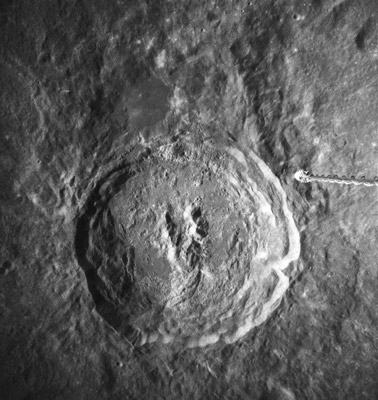January 19, 2004
King of the Craters
Image Credit: NASA Apollo 16 metric Camera AS16-1580 |
|
King of the Craters In the USA, January 19 is Martin Luther King Day, a time to commemorate the life of a leading civil rights leader. What better way to celebrate than to appreciate King crater on the farside of the Moon. The crater was named not for MLK, but for two relatively forgotten American scientists, Arthur King and Edward King. King is probably the most intensively studied crater on the farside because of its unusual central peak and smooth deposits. In general, 76 km wide King is a Copernicus-like complex impact crater, with terraced walls, flat floor and central peak complex. According to analysis of Clementine multi-spectral data, the lobster-like peak is a mixture of different rock types, including highland anorthosites and mare-like gabbros. The flat, darkish materials on the floor of King, along some of its terraces and especially filling the crater above King are thought to be rocks liquified by the energy of impact. The extensive pond above King may have been sloshed out of King by collapse of part of the crater's opposite inner rim, which made the "body" of the lobster. Related Links: Yesterday's LPOD: LeGrand Moon Tomorrow's LPOD: French Moon |
Author & Editor: |
COMMENTS?
Register, Log in, and join in the comments.




